Learn how to make a perfectly buttery, flaky pie crust from scratch using this in-depth tutorial and video. This page includes all of my best success tips, lots of step-by-step photos, and a thoroughly detailed recipe. Millions of readers have been using this helpful guide since 2015. Become a pro with this crust recipe and the rest will be as easy as… eating salted caramel apple pie!
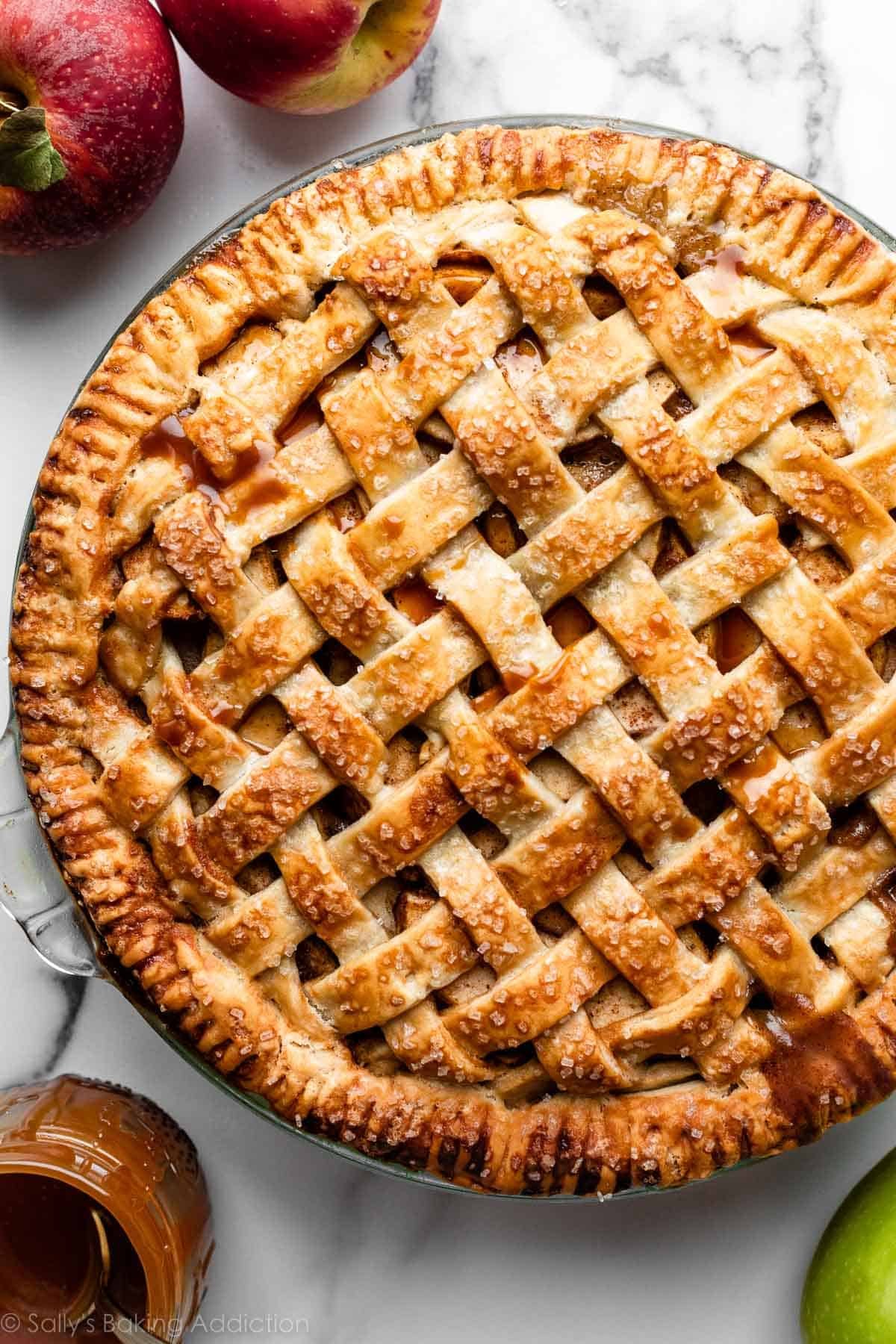
For a baker, there’s nothing more satisfying than making a pie completely from scratch. Pies are often made for special occasions, and there’s a good reason for that: they’re time consuming. This shouldn’t scare you! It should intrigue you. If you’ve ever felt intimidated about making homemade pie crust, I’m here to walk you through it and cheer you on. If I can do this, you can do this.
Pie crust is the foundation for so many delicious desserts (plus savory pies and quiche), so once you build up your confidence in making a crust, you’re opening a door to an entire baking category. And that’s exciting! Whether your favorite pie filling is apple pie or creamy banana cream pie, or even eggs & cheese, the success of the overall pie can really hinge on the quality of the crust.
You wouldn’t hang a beautiful piece of art or favorite photo in a terrible frame, right?
Today I’m teaching you everything about making a buttery, flaky pie crust. This is my absolute favorite pie crust recipe and one of the most popular recipes on this website.
With all the recipe testing that goes into publishing the many pie recipes on this website and in my cookbooks, plus my annual Pie Week, it’s not an understatement to say that I have made a LOT of pies. Along the way, I’ve learned what works and what doesn’t, and I’m happy to share it all with you.
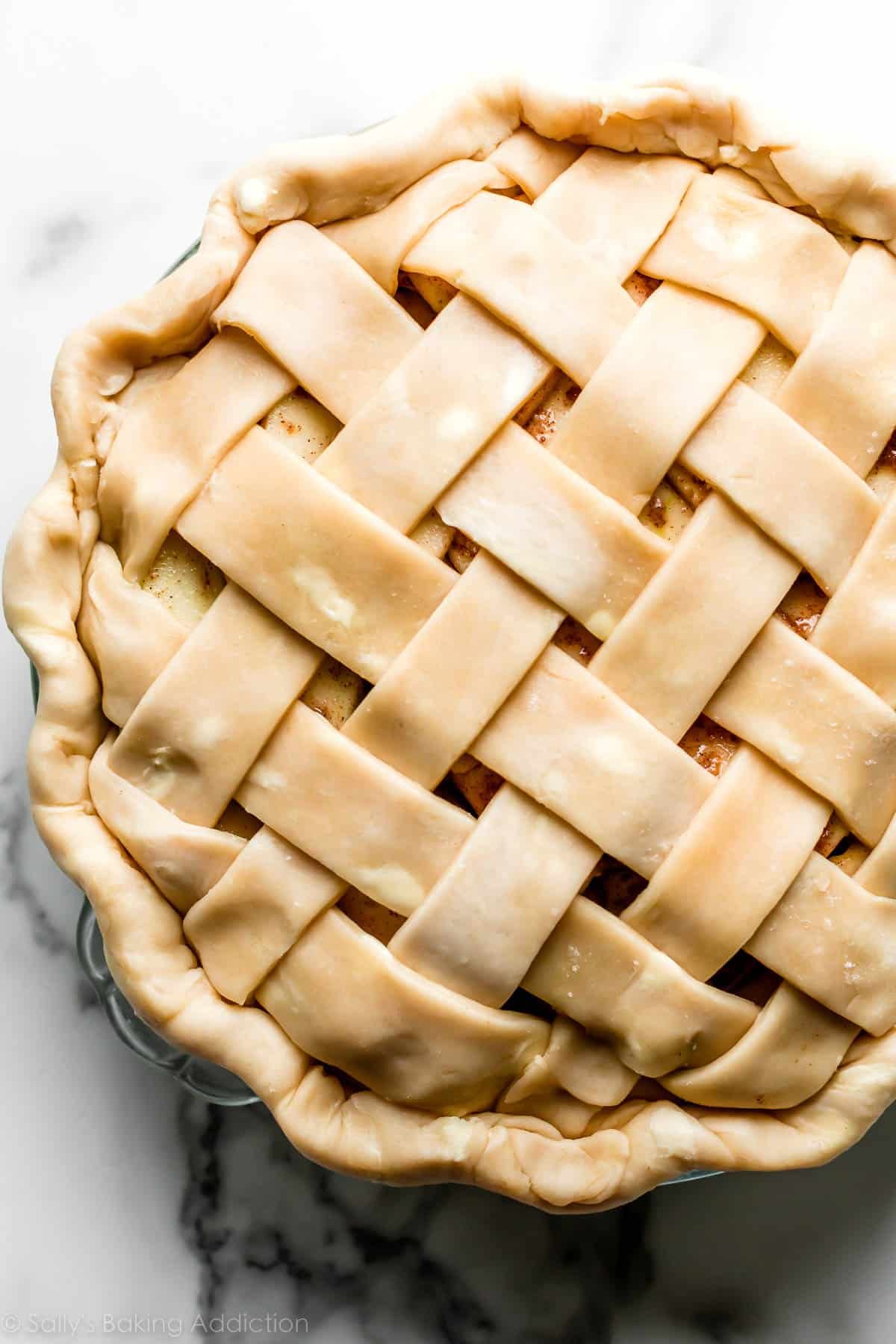
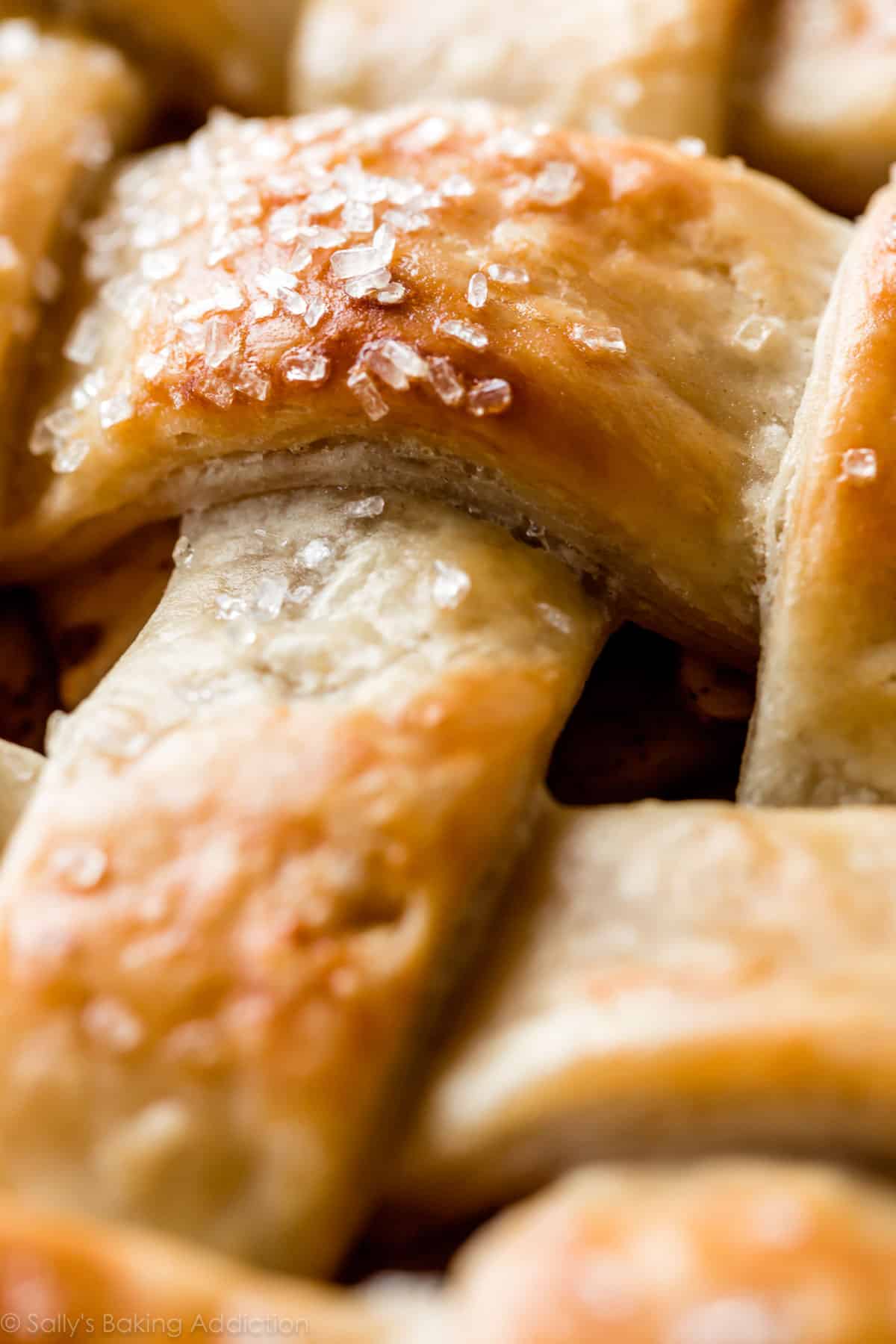
Start With These 5 Ingredients
The ingredient list for pie crust is short & simple:
- Flour: Start with quality flour. Did you know that not all all-purpose flours are equal? King Arthur Unbleached All-Purpose Flour is my go-to for not only pie crust, but for everything. (Not working with the brand, just a true fan!) Why? Its high protein level: “At 11.7% protein, it tops ordinary American all-purpose flours by nearly 2 percentage points.” What does this mean? Baked goods rise higher and stay fresh longer.
- Salt: Enhances the flavor.
- Butter: For that unparalleled buttery flavor and flaky layers.
- Vegetable Shortening: For structure and stability. More on this below.
- Ice water: Liquid brings the dough together. Some recipes call for half water and half vodka, because alcohol doesn’t promote gluten formation, which helps the crust stay flaky and tender. Basically, it’s a gift to anyone who accidentally overworks dough. If you want to try using vodka, use 1/4 cup (60ml) each cold vodka and cold water in this recipe.
You can use this pie dough for so many recipes beyond a traditional pie, too, such as mini pecan pies, mini fruit galettes, apple hand pies, and homemade brown sugar cinnamon pop tarts.
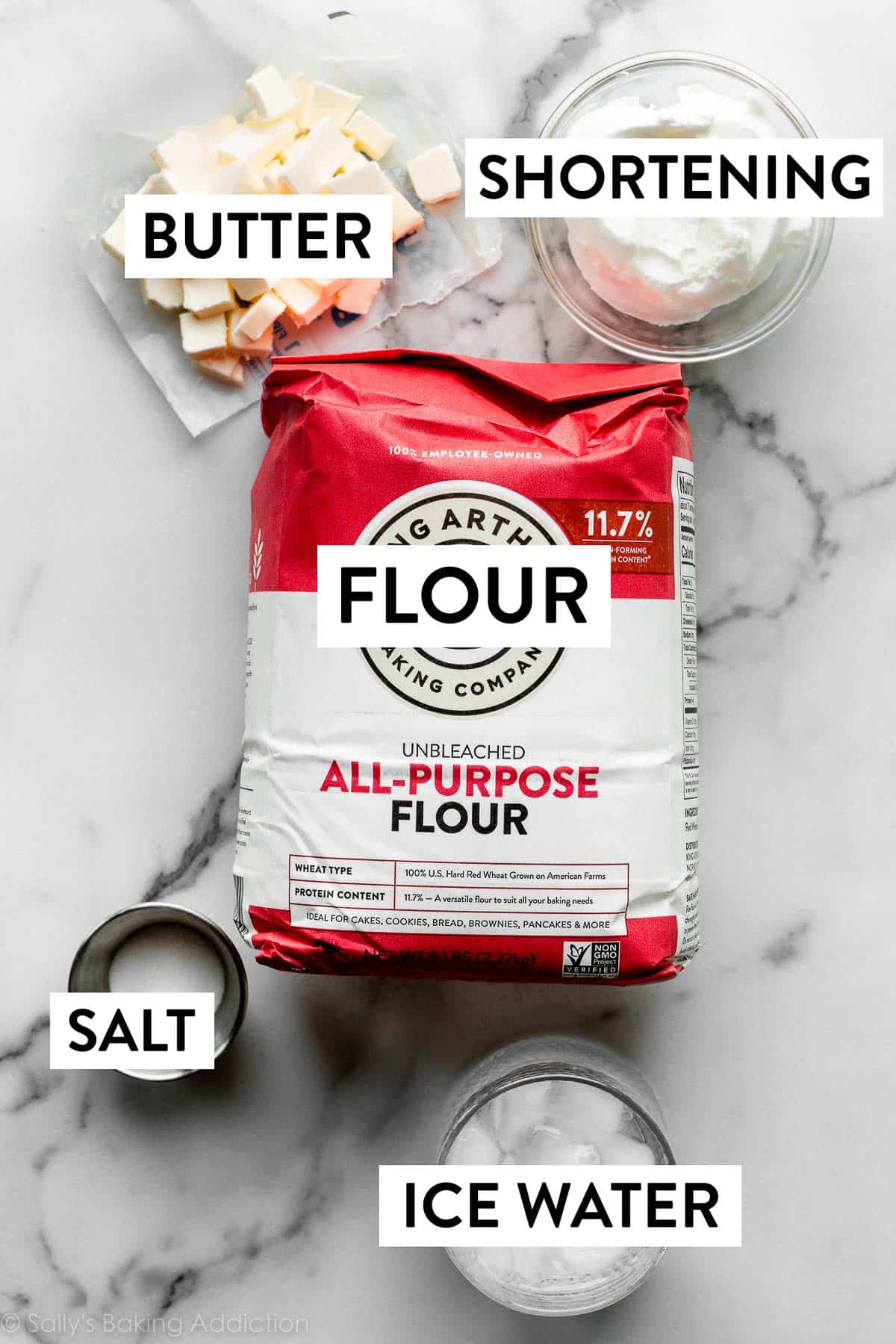
Is Pie Crust Better With Butter or Shortening?
I use BOTH shortening and butter in this pie crust because they work together to make the BEST crust. Buttery, flaky, and tender: the pie-fect trifecta.
- What does butter do? Butter adds flavor and flakiness.
- What does shortening do? Shortening helps the dough stay pliable, which is helpful when you’re rolling and shaping it. Plus, shortening’s high melting point helps the crust stay tender and maintain its shape as it bakes. Have you ever had a butter pie crust lose its shape completely? Shortening is “shape insurance.” 😉
If you don’t want to use shortening, try this all-butter pie crust instead. Let’s compare:
- Using all butter creates a lighter-textured crust and this is due to the butter’s water content. As the crust bakes, the butter’s water converts to steam, lifting up the dough and creating flaky layers. But because of all this butter, the crust doesn’t usually have a perfectly neat-edge/shape compared to the shortening and butter combination.
Both crusts taste buttery and flaky. But overall, this butter-and-shortening crust wins in terms of texture and flavor; AND, if you follow the pie crust recipe carefully, it holds shape too.
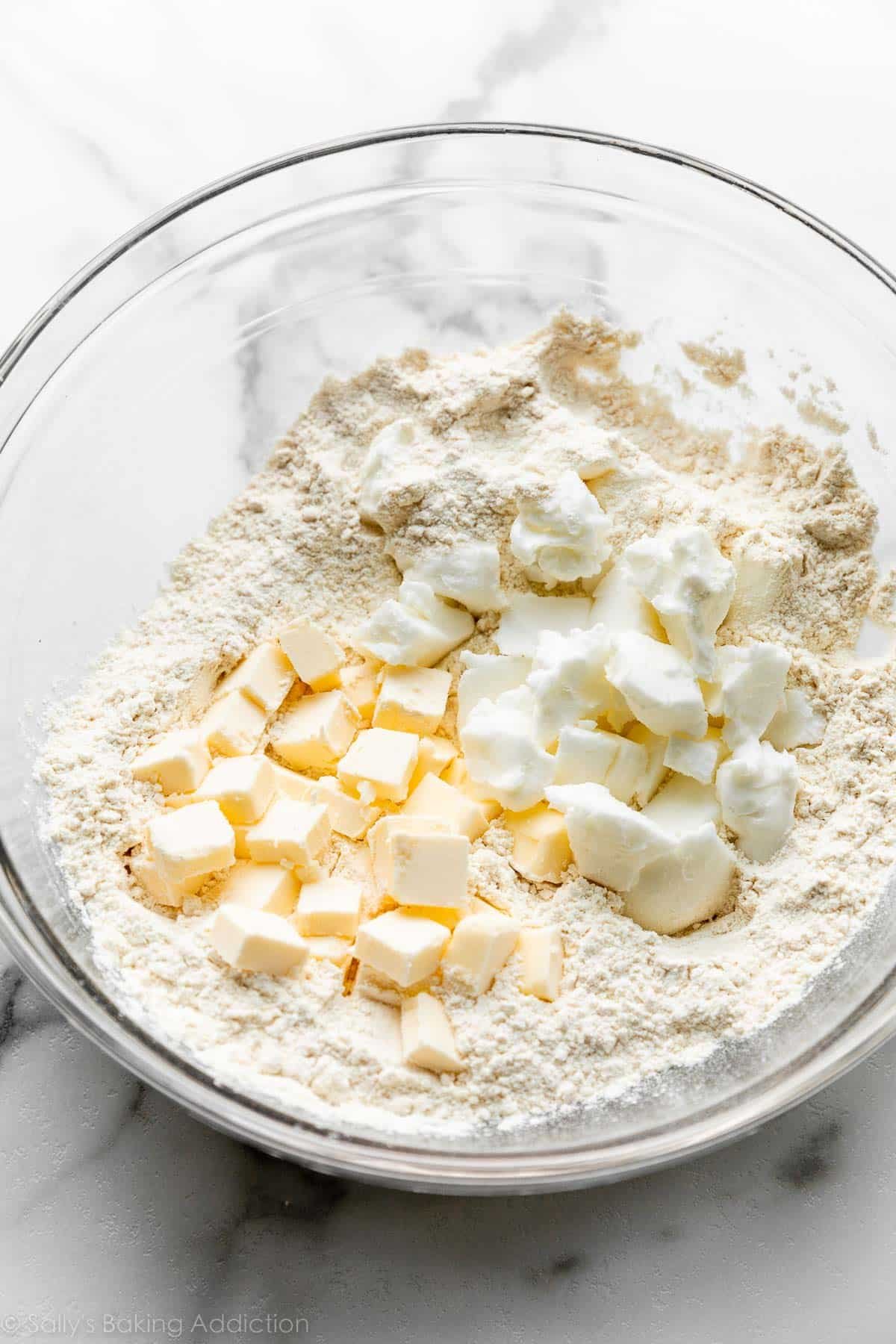
The Secret to Perfect Pie Crust: COLD
The refrigerator is as important as the oven when you’re making a homemade pie.
Why the emphasis on temperature? Keeping your pie dough as cold as possible helps prevent the fats from melting before the crust hits the hot oven. If the butter melts inside the dough before baking, you lose the flakiness. When the lumps of fat melt in the oven as the pie bakes, their steam helps to separate the crust into multiple flaky layers, as explained above. Warm fats will yield a hard, crunchy, greasy crust instead of a tender, flaky crust.
The colder the ingredients, the easier your pie crust is to work with, and the better it will turn out.
Two Tricks to Start as Cold as Possible:
- I keep some of my butter in the freezer and transfer it to the refrigerator a few hours before beginning the crust. This way it is still a little bit frozen and very, very cold. Simply keep the shortening in the refrigerator.
- Mix the dry ingredients together in a large bowl (the flour and salt). Place the bowl in the refrigerator or freezer while you get the rest of the ingredients ready.
These Step-By-Step Photos Will Help
Take the butter and shortening out of the refrigerator. Cube the cold butter and measure out the cold shortening. Give the shortening a little chop—this is actually optional because, truly, the shortening is quite soft even when cold so it’s easy to mix in.
Now it’s time to combine everything. Add the butter and shortening to the dry ingredients, and use a pastry cutter (or 2 forks) to cut in the fats. Some pie crust recipes use a food processor for this, but I don’t recommend it, because it can lead to overworking the fats into the dough, cutting them up too small—which means you’ll need less water and your dough will fall apart. In this step, you’re only breaking up the cold fat into tiny little flour-coated pieces; you’re not completely incorporating it:
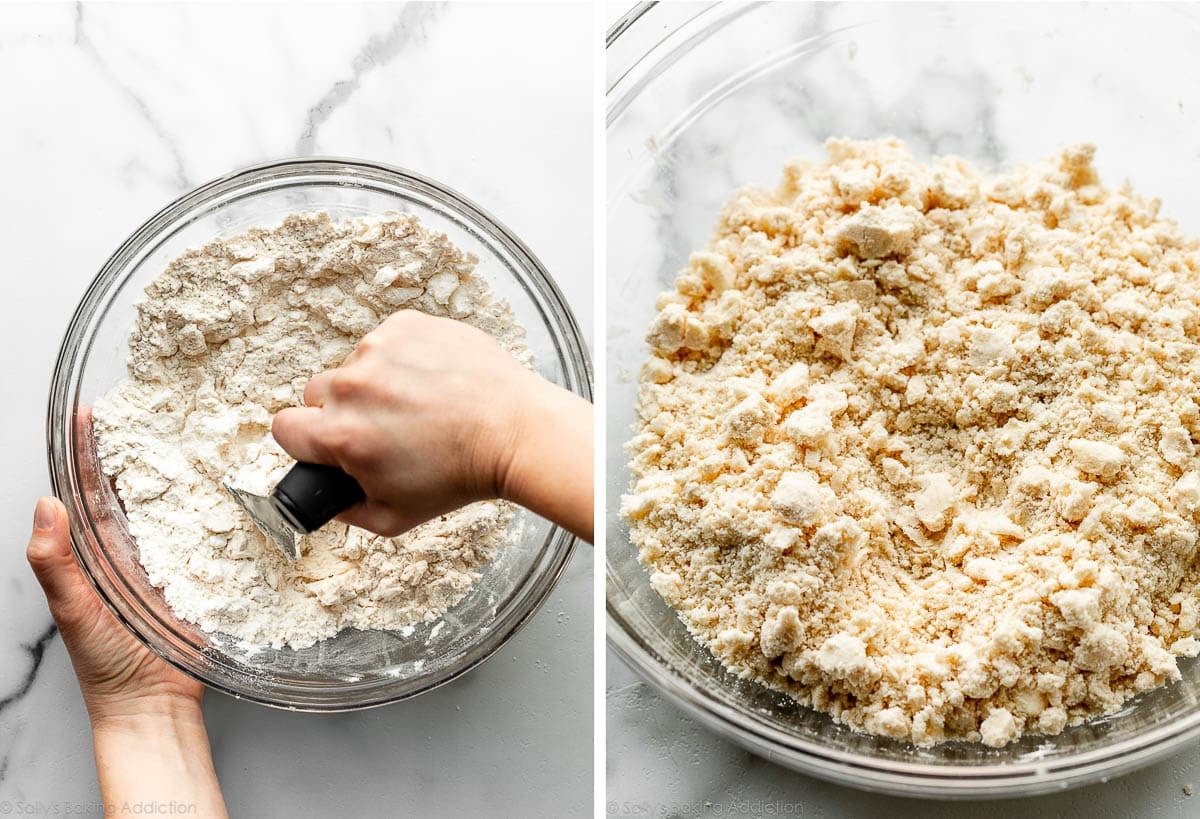
Cut in the fats until the mixture resembles coarse meal—crumbly with lots of lumps, as you see above. You should still have some larger pieces of butter and shortening when you’re done.
From a cup of ice water, measure out 1/2 cup (120ml), since the ice has melted a bit. Drizzle the cold water into the dough 1 Tablespoon (15ml) at a time, stirring after every Tablespoon has been added.
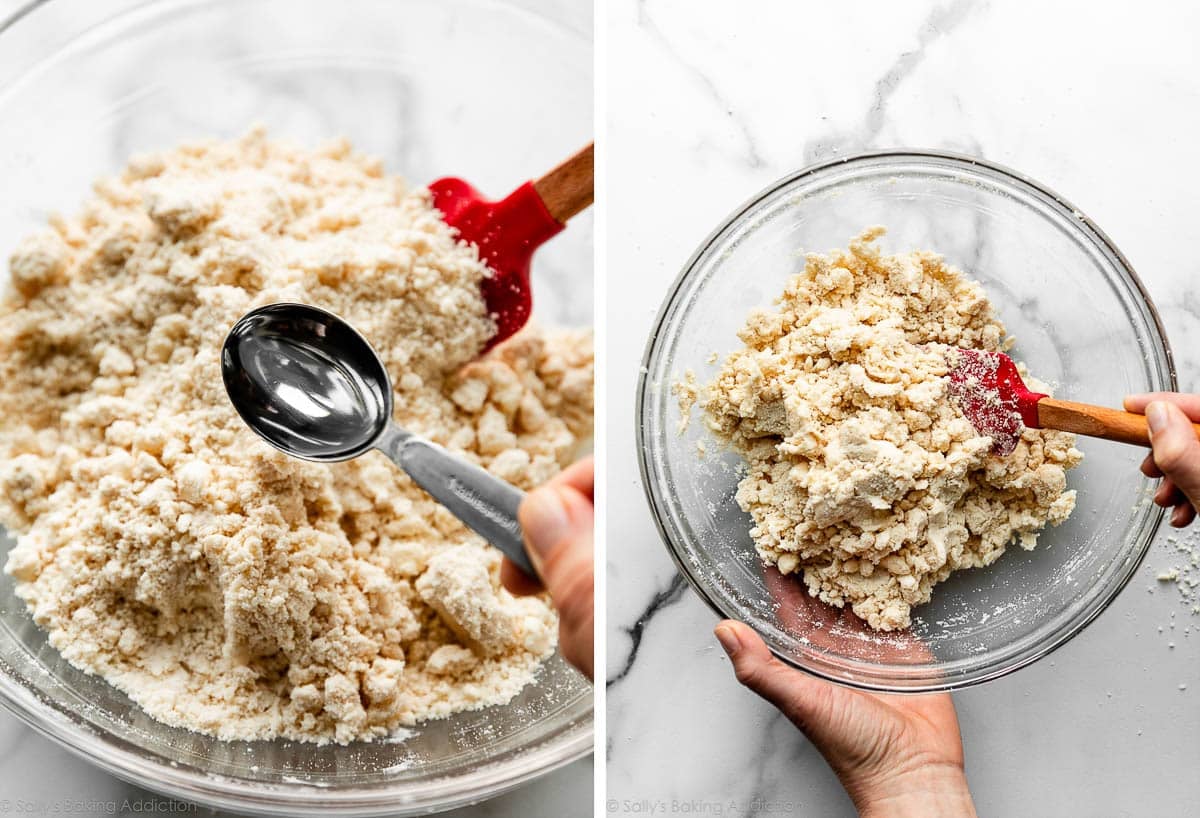
You’ll add just a little water at a time so that you don’t accidentally add too much. Stop adding water when the dough begins to form large clumps. I usually use 1/2 cup (120ml) of water, but if the weather is humid, you may not need as much, and if the weather is really dry, you may need a little more.
If too much water is added, the pie dough will require more flour and become tough.
If too little water is added, you’ll notice the dough is dry and crumbly when you try to roll it out and handle it.
You want the dough to clump together, but not feel overly sticky. Once the dough is clumping together, transfer the dough to a floured work surface.
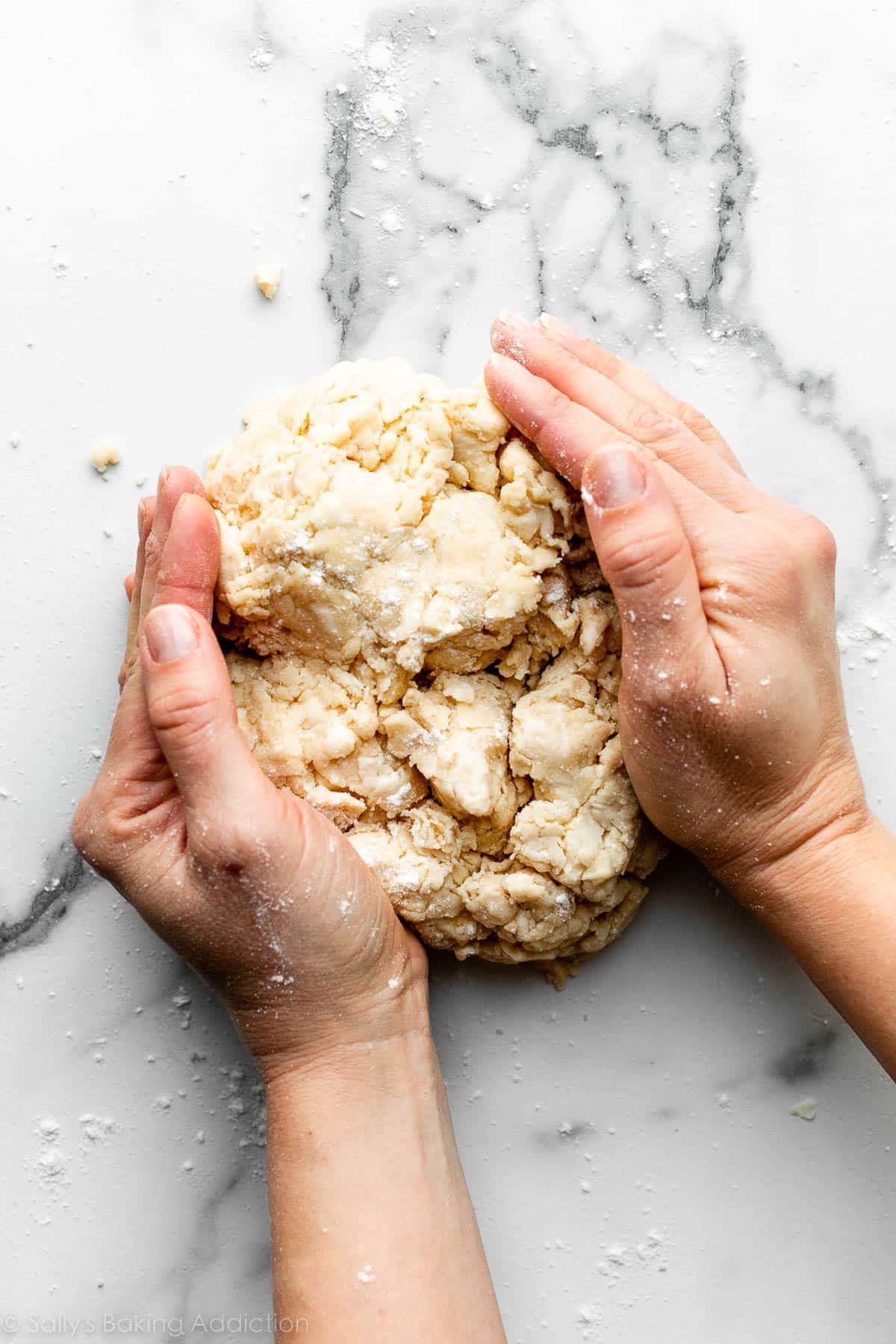
Using floured hands, fold and smush (yes, that’s the technical term) the dough into itself, forming the dough into a ball. Your hands are your best tool, just like when making homemade puff pastry.
The ball of dough should come together easily. If it feels a bit too dry or crumbly, dip your fingers in the ice water and then continue forming the dough with your hands. If it feels too sticky, sprinkle on more flour and then continue forming the dough with your hands.
Once your ball of pie dough has come together, use a sharp knife to cut it in half:
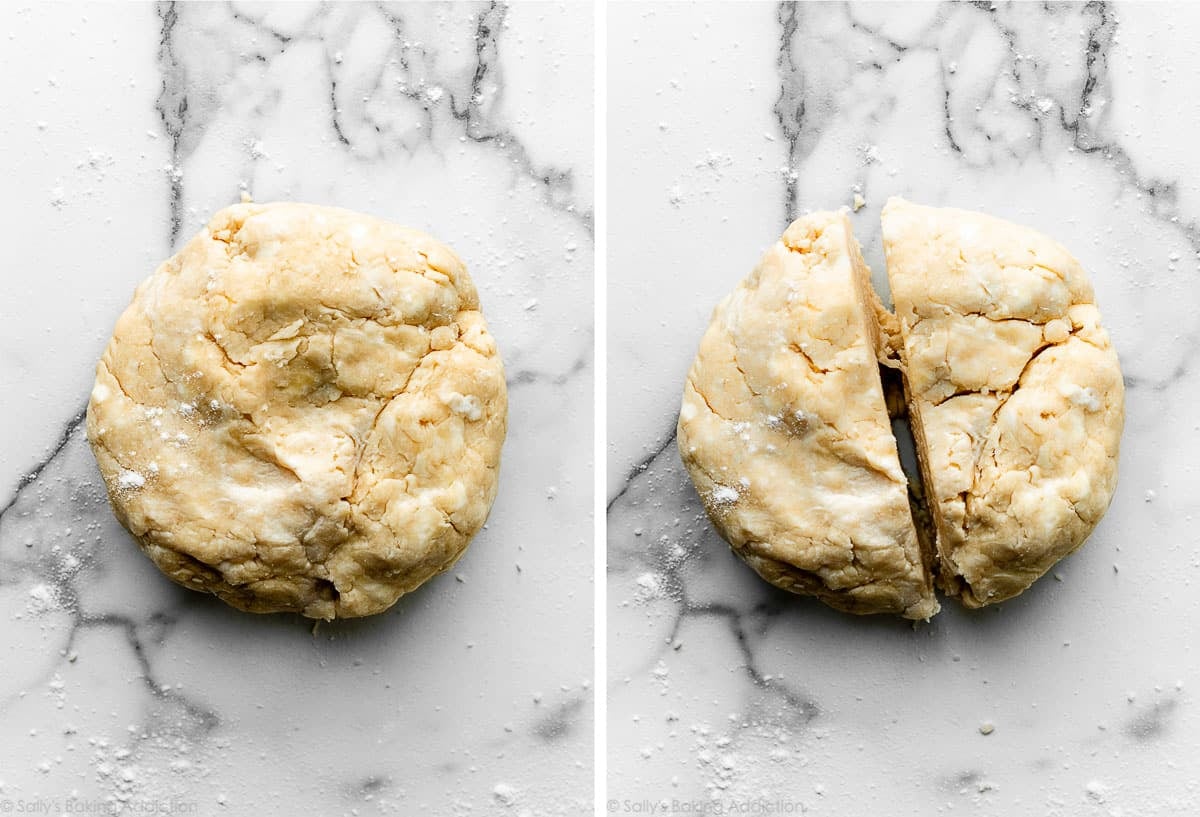
This is enough dough for 2 pie crusts. You can use both crusts for a double-crust pie, like chicken pot pie and strawberry rhubarb pie; or, if your pie doesn’t require a top crust, like coconut cream pie, brownie pie, and lemon meringue pie, save the second pie crust for another pie. You can also roll out the second dough and use cookie cutters to make an easy pie design, like on this pumpkin pie.
Success Tip: Visible Specks and Swirls of Fat in Pie Dough
Take a look at the inside of the dough where you just sliced it. You want to see pieces of butter and flaky layers throughout the pie dough. These specks and swirls of butter and shortening will help ensure a flaky pie dough. They are a GOOD thing!
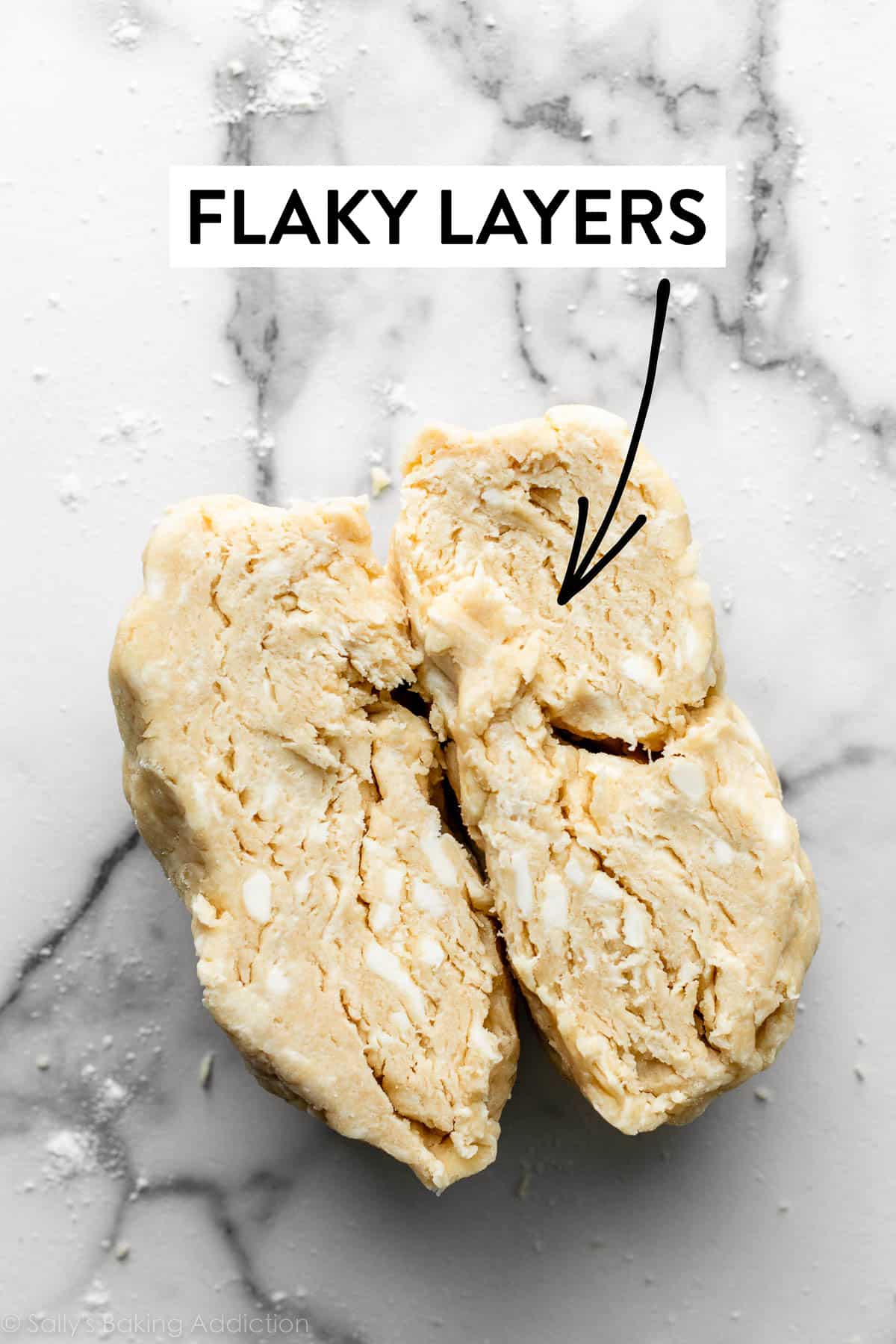
Now your pie dough is ready for a rest in the refrigerator. Flatten each half into 1-inch-thick discs using your hands. The disc shape makes it easier to roll out. Wrap each disc tightly in plastic wrap.
Refrigerate for at least 2 hours or up to 5 days.

Can I Freeze Pie Dough?
Yes, absolutely, and I encourage it! Pie crust freezes beautifully, so it’s a great thing to make ahead of time. Store the tightly wrapped discs of pie dough in the freezer for up to 3 months.
If you know you’re going to want several pies around the holidays, or when your favorite fruit will be in season (cherry pie, anyone?), you can cut down on the amount of time it takes to make pies from scratch the day you want them by making several pie crusts in advance and freezing them.
Thaw the pie crust dough overnight in the refrigerator before rolling it out. It will be extra cold, which is a great starting point.
How to Roll Out Pie Crust
After the dough has chilled for at least 2 hours, you can roll it out. Work with one crust at a time, keeping the other in the refrigerator until you’re ready to roll it out. You’ll need a clean work surface, a rolling pin, and some flour. Lightly flour the work surface, rolling pin, and your hands, and sprinkle a little flour on top of the dough. Use gentle-medium force with your rolling pin on the dough—don’t press down too hard on the dough; you’re not mad at it!
When rolling dough out, start from the center and work your way out in all directions, turning the dough with your hands as you go:
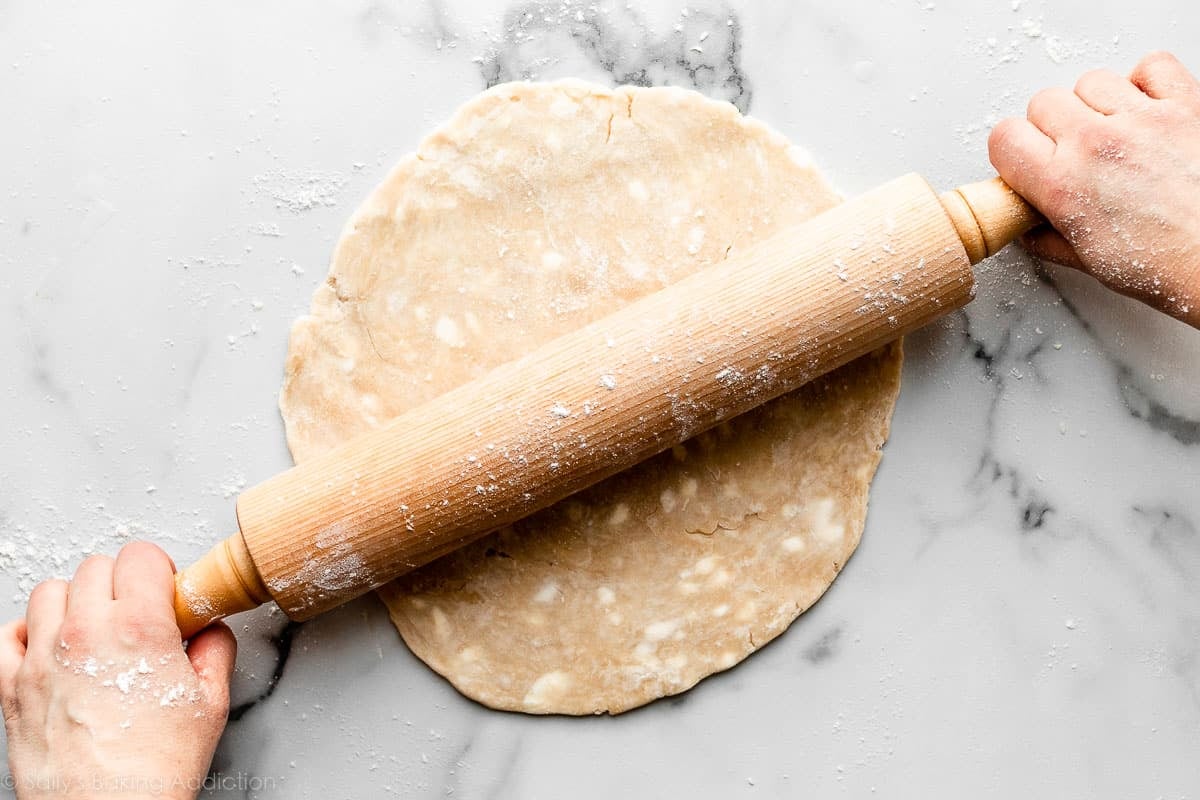
Between passes of the rolling pin, rotate the pie crust and even flip it, to make sure it’s not sticking to your work surface. Sprinkle on a little more flour if it’s sticking. Roll, turn. Roll, turn.
Do you see that beautiful marbling of the butter and shortening throughout the dough? Flaky layers, here you come!
Success Tip: If you notice the dough becoming a lopsided circle as you’re rolling it out, put down the rolling pin and use your hands to help mold the dough back into an even circle:
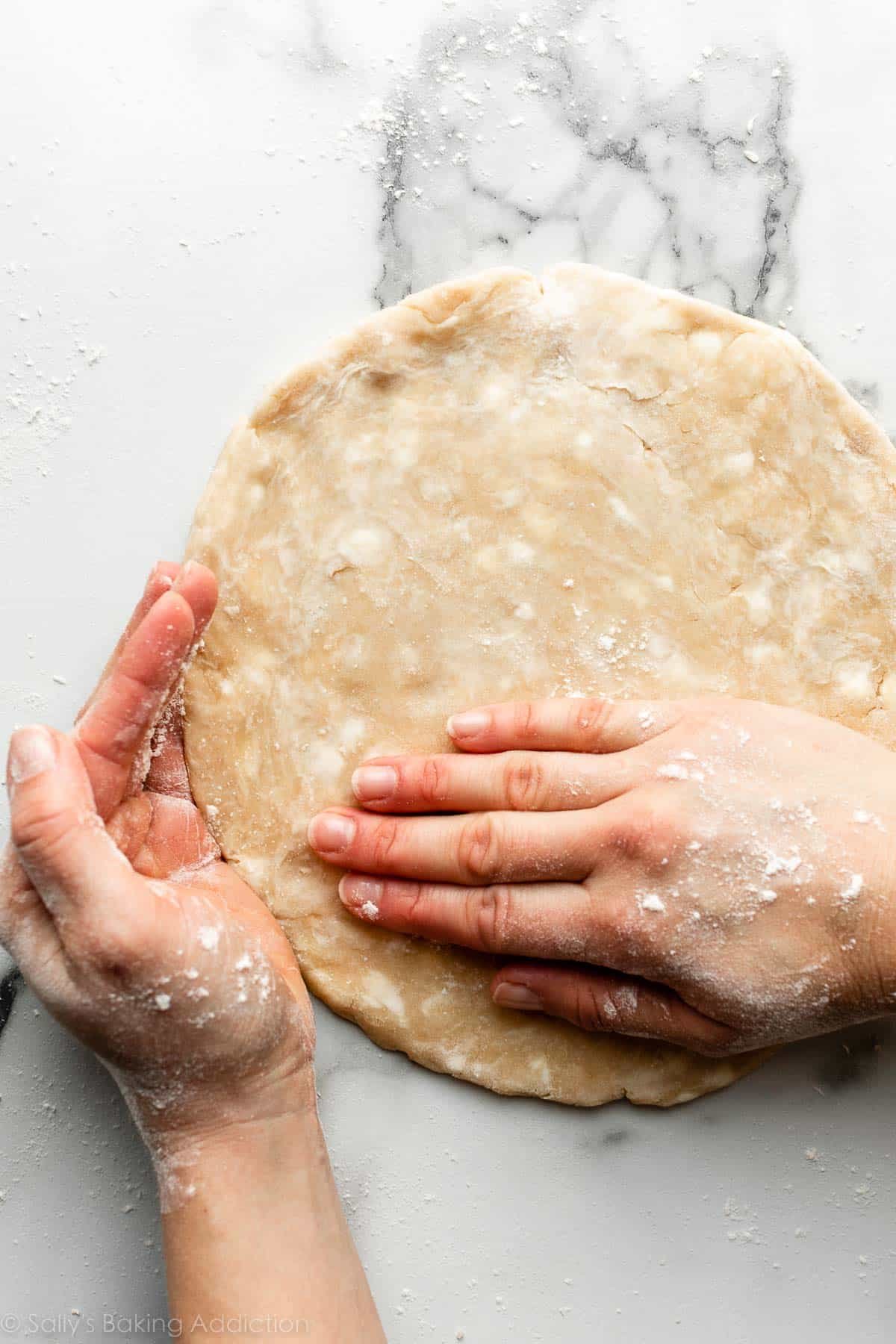
Roll the dough into a thin 12-inch circle, which is the perfect size to fit a 9-inch pie dish. You want enough crust to have some overhang so you can make a decorative edge for your pie.
Your pie dough will be about 1/8-inch thick, which is quite thin.
Success Tip: Since your dough is so thin, use your rolling pin to help transfer the pie crust to the pie dish. Carefully roll one end of the circle of dough gently onto the rolling pin, rolling it back towards you, slowly peeling it off the work surface as you go. Pick it up, and carefully roll it back out over the top of the pie dish. It’s helpful to watch how I do it in the video below.
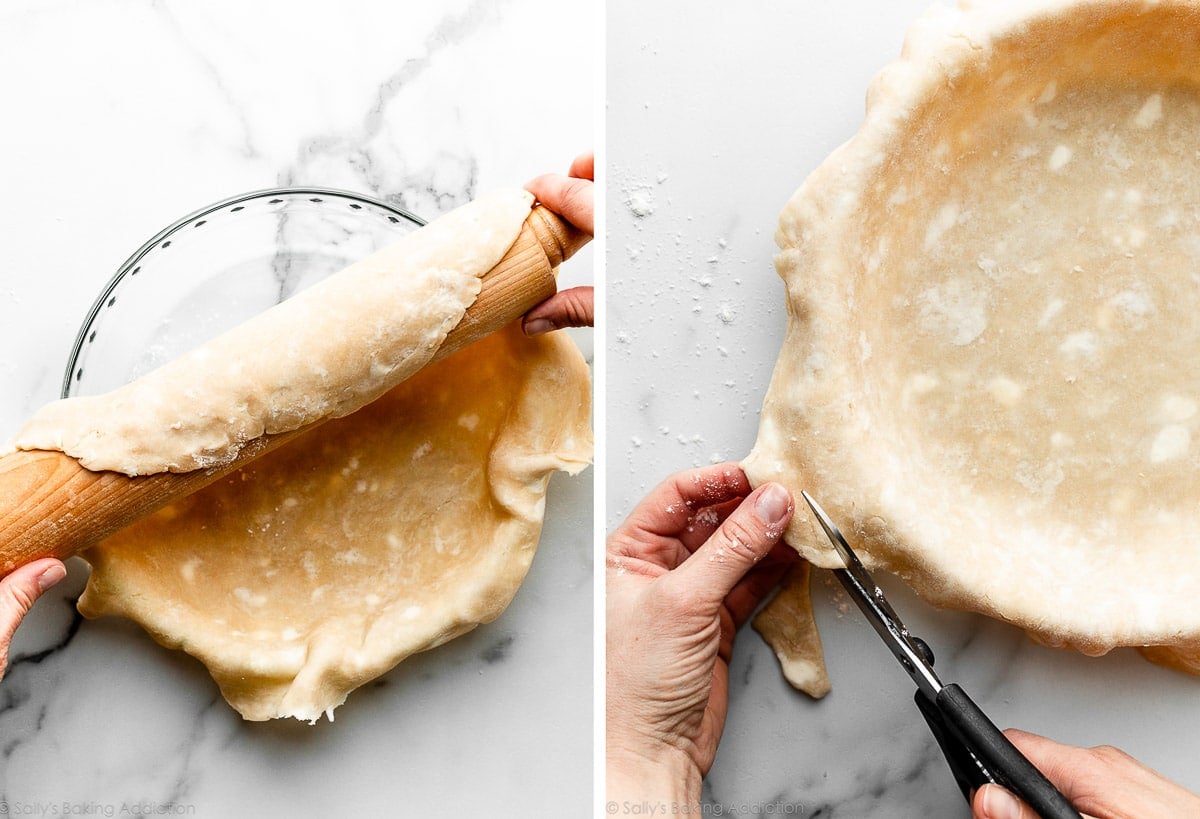
Make sure the pie crust is pretty well centered in the dish, with some overhang all around the sides. Tuck the crust into the pie dish, gently pressing it to the interior all the way around—no air bubbles.
Trim dough around the edges if there’s excess dough in some spots—you want about 1-inch overhang. After you add your pie filling and top crust (such as a lattice pie crust), fold overhang back over and pinch the top and bottom crusts together. Now you can create a pretty edge, such as fluting or crimping. I have a full tutorial on how to crimp and flute pie crust, but here’s a quick overview:
Fluting with fingers: To flute the edges, use a knuckle and 2 fingers to press around the edges of the pie crust, to give it a beautiful and classic scalloped look, like this apple pie.
Crimping with fork: You can also use a fork to crimp the edges, like I do with this peach pie.
Again, review my how to crimp and flute pie crust page and video if you need a little extra help with this step.
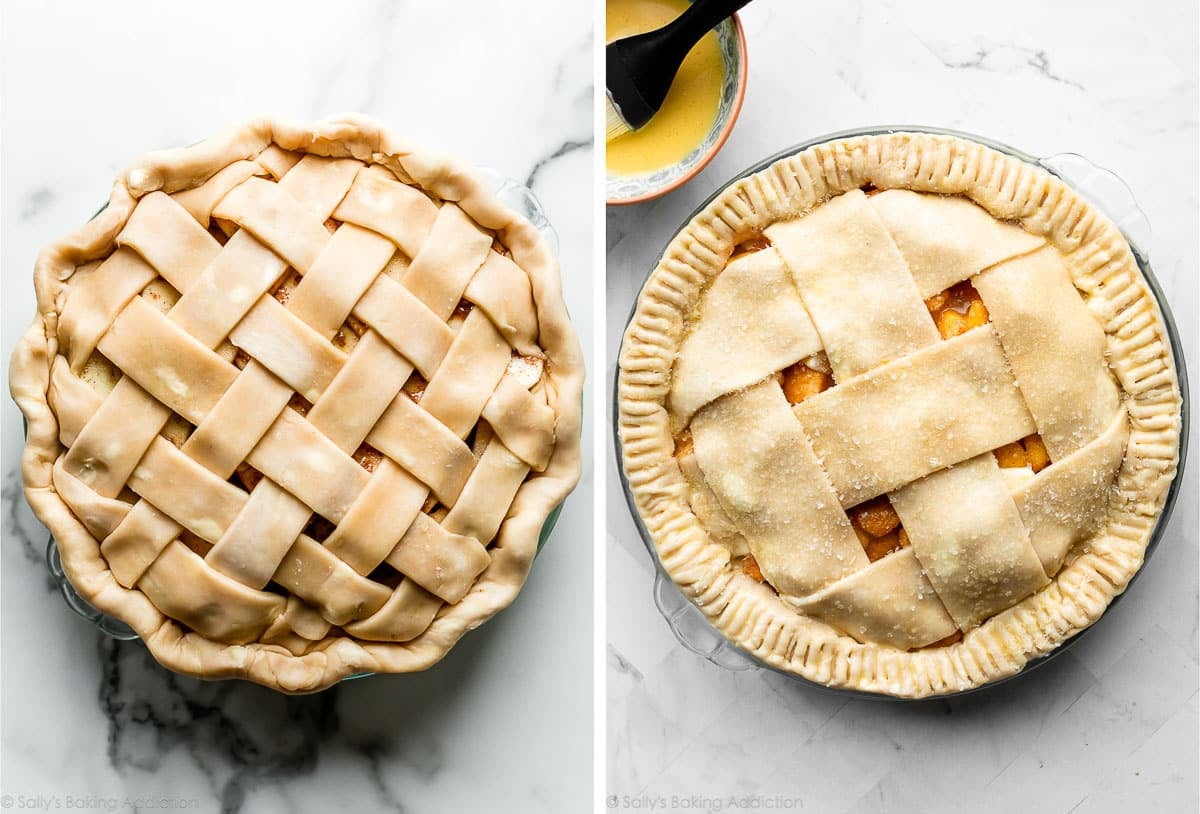
Your pie crust is ready to bake! Follow your pie recipe’s instructions from here; some recipes may call for a fully baked crust, and some may call for a partially baked (par-baked or blind baked) crust. You can read a tutorial on that here in this How to Par-Bake Pie Crust post. And some recipes, like this blueberry pie, don’t require baking the crust at all before adding the filling, because the pie bakes for so long; just spoon/pour the filling right in.
Your pie recipe might call for an egg wash on the dough and for that, use a pastry brush. And if you bake a lot of pies, this list of 10 best pie baking tools will be helpful for you.
Troubleshooting Pie Crust
- Pie crust is tough: Tough crusts are the result of not enough fat in the crust, as well as overworking the dough. Use the recipe below (plenty of fat) and avoid handling the dough more than you need.
- Don’t have enough pie dough: This recipe yields 2 pie crusts. To ensure you have enough pie dough for overhang and a pretty topping, roll your dough out to a 12-inch circle, about 1/8 inch thick.
- Pie crust shrinks down the sides of the dish when baking: This can happen when par-baking a pie crust. See section below.
- Pie dough is dry & cracking around edges when rolling: Use enough ice water when preparing the pie dough. If you work the fats into the dry ingredients too much, the dough will feel too wet before you can add enough water. (And the dough will be dry and thirsty.) Do not overwork the fats in the dry ingredients—you still want those nice crumbles. If it’s too late and you notice the edges of your pie crust are cracking as you roll it out, dip your fingers in ice-cold water and meld the edges back together. Wait a minute, and then try rolling out again.
- Pie dough is falling apart & crumbling when rolling: The dough is likely crumbling because there’s too much fat, and not enough flour and water. Again, this is usually a result of fat being worked in too much, which can easily happen if the ingredients weren’t cold enough. (Refrigerate those dry ingredients before you start!) If it’s too late and the pie dough is crumbling as you roll it out, try adding more water AND more flour. Sprinkle a tiny bit of ice water and flour onto the cracks and crumbled pieces, and gently work it all in with your fingers. Wait a minute, and then try rolling out again.
Gently work ice water drops and flour into your crumbly pie dough to bring it back together:
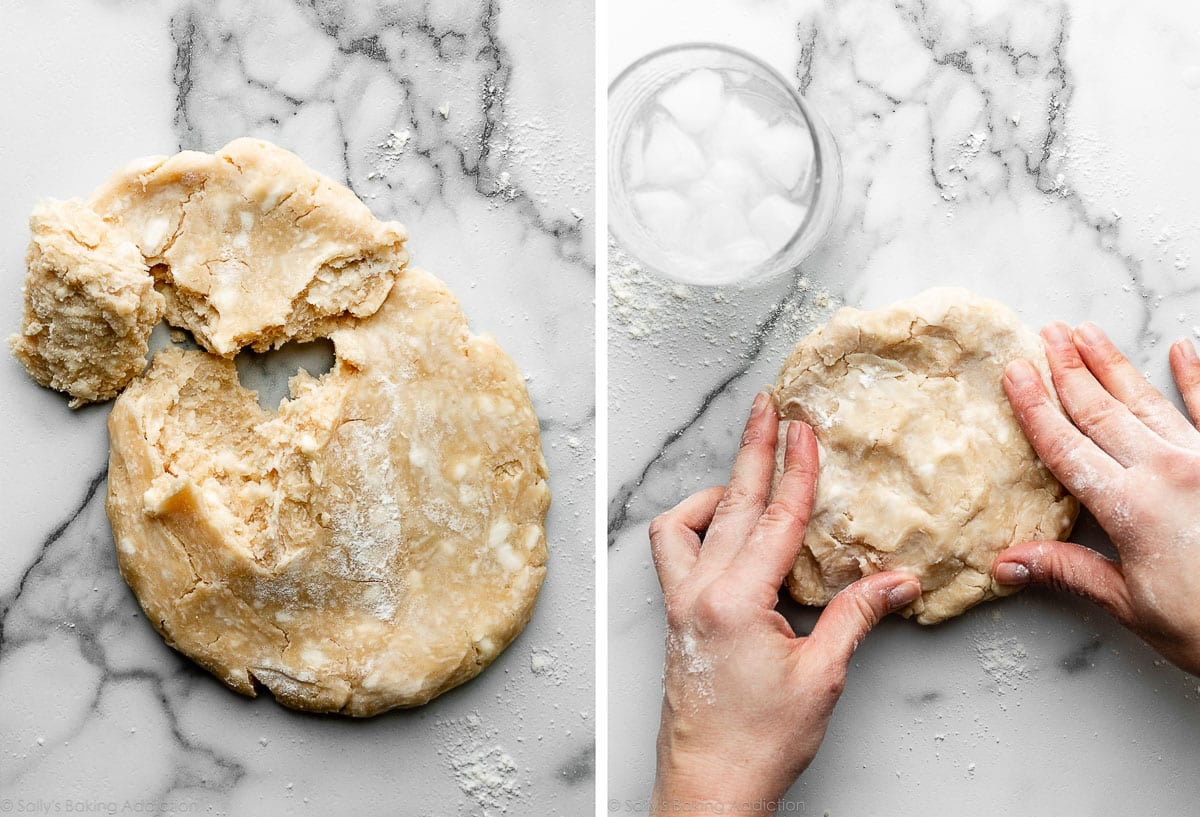
Blind Baking Pie Crust
If your pie recipe requires a fully baked or par-baked pie crust before adding the filling, follow the directions and success tips in this How to Par-Bake Pie Crust guide. You need 2 packs of pie weights, which are metal or ceramic beads that serve to weigh down the crust to prevent the puffing/shrinking. You could use dried beans instead. Whichever you choose, be sure to line the crust with parchment paper, then fill the empty pie crust shell with the weights prior to baking. Without pie weights, the dough will puff up, and then shrink down the sides.
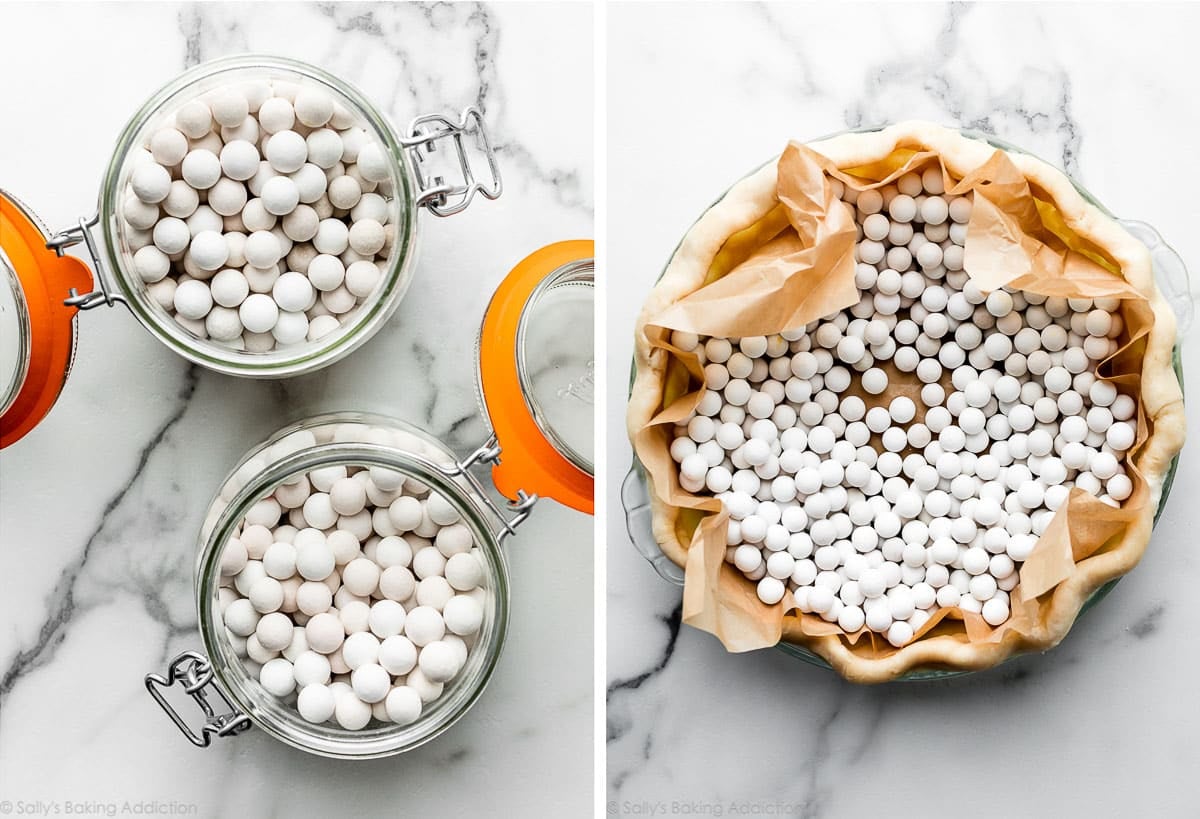
Pie Crust Success Tips
- Use a glass pie dish. I prefer using a glass pie dish when I make pie. Why? Glass dishes conduct heat evenly, which allows the bottom of the crust to bake thoroughly. Also, you’ll be able to see when the sides and bottom of the crust have browned.
- The refrigerator is pie dough’s best friend. Keep everything cold every step of the way: ingredients, the bowl, and the dough before rolling. When taking the pie crust out of the refrigerator to roll out and fill, make sure your pie filling is ready to go. If not, keep the pie crust in the refrigerator until it is.
- Keep dough cold when rolling out: Warm pie dough is unworkable. If the dough becomes too warm when you’re rolling it out, stop what you’re doing, pick it up as gently as you can, put it on a plate or small baking sheet, and then cover and refrigerate it for 10–20 minutes.
- Protect the crust edges from burning: Use a pie crust shield to prevent the edges from burning. A shield keeps the crust edge covered, but the center of the pie exposed, protecting the edges. I usually just make a pie shield out of a piece of aluminum foil. Take a piece of aluminum foil and fold it in half. Cut out a half circle. When you open it back up, you’ll have a square of foil with a circle cut out of the center. If you notice the edges of your pie crust are browning before the pie has fully baked, carefully and gently place the foil over the top of the pie, centering the cut-out hole over the pie. Carefully (obviously it’s very hot!) and lightly tuck the sides of the foil around the pie crust edges, then let the pie finish baking.
- Create a beautiful topping: For designing the top crust, see How to Lattice Pie Crust, How to Braid Pie Crust, or these Pie Crust Designs. And here is my tutorial on How to Crimp and Flute Pie Crust, too.
For more pie crust inspiration, see my graham cracker crust and homemade chocolate pop tarts (with a chocolate crust!).
Print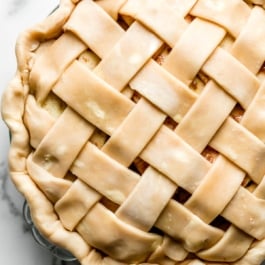
Homemade Buttery Flaky Pie Crust Recipe
- Prep Time: 15 minutes
- Cook Time: 0 minutes
- Total Time: 2 hours, 15 minutes
- Yield: 2 pie crusts (1 lb, 8 ounces dough total)
- Category: Pie
- Method: Baking
- Cuisine: American
Description
This recipe is enough for a double crust pie. If you only need 1 crust for your pie, freeze the other half per the Freezing Instructions below. Is your pie dough tearing, cracking, or crumbling as you try to roll it out? See recipe Notes.
Ingredients
- 2 and 1/2 cups (315g) all-purpose flour (spooned & leveled), plus more for shaping and rolling
- 1 teaspoon salt
- 6 Tablespoons (85g) unsalted butter, chilled and cubed
- 2/3 cup (130g) vegetable shortening, chilled
- 1/2 cup (120ml) ice cold water
Instructions
- Whisk the flour and salt together in a large bowl.
- Add the butter and shortening. Using a pastry cutter or two forks, cut the butter and shortening into the mixture until it resembles coarse meal (pea-sized bits with a few larger bits of fat is OK). In this step, you’re only breaking up the cold fat into tiny little flour-coated pieces; you’re not completely incorporating it. Do not overwork the ingredients.
- Measure 1/2 cup (120ml) of water in a cup. Add ice. Stir it around. From that, measure 1/2 cup (120ml) of water, since the ice has melted a bit. Drizzle the cold water in, 1 Tablespoon (15ml) at a time, and stir with a rubber spatula or wooden spoon after every Tablespoon has been added. Stop adding water when the dough begins to form large clumps. I always use about 1/2 cup of water, and need a little more in dry winter months. Do not add any more water than you need.
- Transfer the pie dough to a floured work surface. Using floured hands, fold the dough into itself until the flour is fully incorporated into the fats. The dough should come together easily and should not feel overly sticky. Avoid overworking the dough. If it feels a bit too dry or crumbly, dip your fingers in the ice water and then continue bringing dough together with your hands. If it feels too sticky, sprinkle on more flour and then continue bringing dough together with your hands. Form it into a ball. Use a sharp knife to cut it in half. If it’s helpful, you should have about 1 lb, 8 ounces dough total (about 680g). Gently flatten each half into 1-inch-thick discs using your hands.
- Wrap each tightly in plastic wrap. Refrigerate for at least 2 hours and up to 5 days.
- After the dough has chilled for at least 2 hours, you can roll it out. Work with one crust at a time, keeping the other in the refrigerator until you’re ready to roll it out. Lightly flour the work surface, rolling pin, and your hands, and sprinkle a little flour on top of the dough. Use gentle-medium force with your rolling pin on the dough—don’t press down too hard on the dough; you’re not mad at it! When rolling dough out, start from the center and work your way out in all directions, turning the dough with your hands as you go. Between passes of the rolling pin, rotate the pie crust and even flip it, to make sure it’s not sticking to your work surface. Sprinkle on a little more flour if it’s sticking; don’t be afraid to use a little more flour. If you notice the dough becoming a lopsided circle as you’re rolling it out, put down the rolling pin and use your hands to help mold the dough back into an even circle. Roll the dough into a very thin 12-inch circle, which is the perfect size to fit a 9-inch pie dish. Your pie dough will be about 1/8 inch thick, which is quite thin. Visible specks of butter and fat in the dough are perfectly normal and expected.
- Because your dough is so thin, use your rolling pin to help transfer the pie crust to the pie dish. Carefully roll one end of the circle of dough gently onto the rolling pin, rolling it back towards you, slowly peeling it off the work surface as you go. Pick it up, and carefully roll it back out over the top of the pie dish. It’s helpful to watch how I do it in the video below.
- Proceed with the pie per your recipe’s instructions. If your dough requires par-baking, see helpful How to Par-Bake Pie Crust tutorial.
Notes
- Make Ahead & Freezing Instructions: Prepare the pie dough through step 5 and freeze the discs for up to 3 months. Thaw overnight in the refrigerator before using in your pie recipe.
- Special Tools (affiliate links): Large Glass Mixing Bowl | Pastry Cutter | Rolling Pin | For more tools you may need to completely assemble and bake your pie, see my 10 Best Pie Baking Tools list.
- Salt: Use regular table salt. If using kosher salt, use 1 and 1/4 teaspoons.
- Shortening: This recipe uses a butter and shortening combination. Butter for flakiness and flavor, and shortening for its high melting point and ability to help the crust hold shape. You can use butter-flavor shortening if desired. If you want to skip the shortening, feel free to try this all-butter pie crust instead. Some readers have substituted lard for shortening in this recipe with success.
- Can I use a food processor? You can use a food processor to bring the dough ingredients together in step 1, but I find it quickly overworks the dough. For best results and a light, flaky crust, I recommend a pastry cutter.
- Pie dough is dry & cracking around edges when rolling: Use enough ice water when preparing the pie dough. If you work the fats into the dry ingredients too much, the dough will feel too wet before you can add enough water. (And the dough will be dry and thirsty.) Do not overwork the fats in the dry ingredients—you still want those nice crumbles. If it’s too late and you notice the edges of your pie crust are cracking as you roll it out, dip your fingers in ice-cold water and meld the edges back together. Wait a minute, and then try rolling out again.
- Pie dough is falling apart & crumbling when rolling: The dough is likely crumbling because there’s too much fat, and not enough flour and water. Again, this is usually a result of fat being worked in too much, which can easily happen if the ingredients weren’t cold enough. (Refrigerate those dry ingredients before you start!) If it’s too late and the pie dough is crumbling as you roll it out, try adding more water AND more flour. Sprinkle a tiny bit of ice water and flour onto the cracks and crumbled pieces, and gently work it all in with your fingers. Wait a minute, and then try rolling out again.
- More Crusts: If you need more than 2 pie crusts, make another separate batch of dough. Doubling or tripling the recipe leads to over- or under-working the dough, which ruins all of your efforts.



















This is my go-to crust recipe. It always comes out great.
Is there a recipe for the single-crust gluten-free pie dough? If the recipe in my book calls for a food processor to make it, can I use a pastry cutter instead?
Hi Allison, we do not have a gluten-free pie crust recipe. You can typically use a pastry cutter in place of a food processor to help cut the butter into the flour. Sorry we can’t be of more help here!
I’ve made this crust many times before and it always turned out perfectly. However, this time the dough felt sticky and I could not roll it out. It wasn’t dry but was breaking and i just couldn’t lift it. I may be wrong but have the numbers in the recipe changed? I vaguely remember that there was more flour when I made it earlier. Looking at more recent comments, it seems that several people have had issues. Can you recheck the measurements please – I used to love this recipe!
Hi Isha, I’m just seeing this comment now. I haven’t changed the amount of flour this recipe calls for since I originally published the recipe in 2015. I know Crisco has slightly modified its shortening in recent years. I usually use Spectrum brand.
So glad I was reading thru these comments. I had a terrible time with my crust tonight. I was using buttered flavored Crisco. I have always used this. I was wondering about if something had changed. I will definitely look for the shortening that you mentioned. Thanks for all the great recipes and step by step picture instructions.
We use regular cake flour in South Africa and not all purpose flour. Please explain the ratio if the recipe ask for 2 and 1/2 cups of all purpose.
Hi Anthea, unfortunately, cake flour is much too light to use in this pie crust recipe. For best taste and texture (and so you don’t waste your time trying to adapt this recipe since it may not work properly), it may be more useful to find a recipe that is specifically formulated to use cake flour. Thank you!
Thanks for the recipe! I do have one question – I chilled all my ingredients before hand as per the recipe, but when i took the shortening out of my fridge it was rock-hard, much harder than the butter. Working it into my dough was difficult and took quite some time – any idea what happened or what to do differently? The brand was Kremelta, if that makes any difference.
Thanks!
Hi Lillian! We recommend using a shortening like Crisco, that has a soft and pliable texture. (Imperial or Crisco shortening sticks work great, too.) We’ve never used Kremelta, but it looks like a very different type of shortening. If you can find a more traditional shortening, that should definitely work better!
I am fan and have made many of your recipes, but I have tried many times to use this pie crust recipe and it always falls apart and is difficult to fit into the pie plate. I now use a different pie crust recipie which has interesting instructions. It is from “The Pie and Pastry Bible” by Rose Levy Beranbaum. It is for a flaky pie crust and found on page 22. She divides butter, refridgerates a portion and freezes another portion and plases the flour in a plastic bag in the freezer for 30 minutes. Using a food processor, she first incorporates the refridgerated portion into the flour until crumbly, then adds the frozen portion with a few bursts. Lastly, she adds cold water and apple cider vingear to make what appears to be a crumbly mixture. This mixutre is returned to the plastic bag where it is kneaded into a smooth mass, then formed into disk and refridgerated. It rolls out very nicely and is easy to place on the pie pan without tearing. Results are a flaky and easy to make crust.
Wow! Never been a more perfect pie crust, and I’ve made many. Came out crispy yet soft in the right places. I’m printing and saving this.
Excellent pie dough recipe. Definitely using this one again.
Only adjustment I will make in the future is to NOT chill my shortening (I use Spectrum Shortening) because it was hard as a rock and I had to squeeze the pieces with my fingers to incorporate into the dough. My house is very dry in the winter (18% humidity) so I definitely needed more water. Thanks for a good recipes and the very helpful video and tips!
Used this recipe for my first ever attempt at a pie crust. I consider myself a decent cook and more than capable of following a recipe. With the video and tips this came out perfect on the first try. I get compliments from people who do not like apple pie because of this crust. I will be back to get more of your knowledge.
I’m feeling very silly and read 2/3 cup of butter instead of shortening ahahha
but..
it turned out fantastic when I sanded it together with my hands.
I did cheese grate the butter though. I added water as needed.. made apple pie tarts. Turned nice crispy and fluffy..
I will try with pig lard today lol
I’ve made this crust several times, each time trying to improve it. I usually use half Kerry Gold unsalted butter and half Crisco. Any thoughts on that? Also, I have a convection oven. Is that useful when blind baking a crust?
Thanks, Sally! I’ve won a few ribbons with your recipes!
Hi Andy, European style butter, like Kerry Gold, is wonderful in cooking but we find it’s difficult to use in baking recipes– especially pie crust. Its higher fat percentage, while making the butter tasty, creates too much grease in doughs. We always recommend conventional settings for baking (not convection/fan). The flow of air from convection heat can cause baked goods to rise and bake unevenly and it also pulls moisture out of the oven. If you do use convection/fan settings for baking, lower your temperature by 25 degrees F and keep in mind that things may still take less time to bake. Hope this helps, and thank you so much for making and trusting our recipes!
I’ve never posted a review before, but had to for this. It’s A-mazing! My pastry has always been tough and shrinky. This is lovely, so light and crispy. Totally suggest watching the video as there are lots of great pointers in there. I used a combination of butter and beef dripping (I believe you call it tallow in the States) as I am against the consumption of vegetable oils. Made mini quiches with it – made 15 out of half the batch in standard UK sized muffin tins.
Thanks!
Question: can I freeze the pie crusts AFTER I place them into the pie plates, then thaw in the fridge and use for my recipe? Sort of like the premade frozen pie shells you can buy at the store. 🙂 Thanks!
Hi Debbie, that should work just fine as long as you cover it tightly and have the freezer space! Just be careful not to put the frozen pie dish straight into the oven as the sudden change in temperature can cause dishes to shatter.
Actually, I was thinking of placing them in aluminum foil pie plates to freeze (well wrapped), then after thawing putting it into my Emile Henry pie plate to bake. Thanks!
This recipe has always worked for me but I tried freezing and something didn’t quite go well. I had one of them turn a grayish color, seemed almost like a rice flour, gluten texture. Could it be I had it in the fridge too long after unfreezing. I admit it was there a couple days.
Hi Kathy! Was the pie dough completely sealed in a container or freezer bag? We do recommend using it the day after thawing.
Thanks for making me look like a rockstar the first time I made your double crust chicken pot pie. I have never made pie crust before!
I usually make a lard pastry and have family comments that it is excellent. I wanted to make a pastry with butter for quiche and I’m wondering whether lard can be substituted for the vegetable shortening as that is what I have at home.
Hi Kathleen, Some readers have used lard in place of shortening with success!
Great Crust!!! Everyone love’s it…
I did find that 2 1/2 cups = 400g
Not not ( 315g) … Maybe a Typo error!!
Thank for a great site…….
A cup of flour weights 120 gm*. The weight of flour can fluctuate according to humidity/lack of humidity. I learned in Culinary School when baking to always weight flour and dry ingredients. It makes for a more consistent product.
*According to the King Arthur Web site.
Can this recipe be used for fried pies?
Which type of vegetable shortening do you recommend for this recipe?…
Hi Stephanie, we often use Crisco brand, but any brand will work.
I hate to ask, but, can this pie crust be made gluten-free without ruining it? If so, will you please recommend which flour, or offer a recipe for a combination of ingredients to make an APF? Thank you.
Hi Lupe, We haven’t tested this recipe with gluten free flours, but some readers have reported success using 1:1 flour substitutes (like Cup4Cup). If you try it, let us know how it goes!
I bake a fair amount of French pastries, which I’ve never had a problem with (I blind bake as well as brush them with egg whites for a barrier against liquids to avoid soggy bottom). I tried this due to my hypothesis that a chicken pot pie needed a sturdier crust than what a French torte requires. I was wrong. This dough fell apart, the combination of both butter and shortening making it a weak molecular structure. I added quite a bit of extra water and flour though it still fell apart. After the blind bake, the crust seemed wet (because, with the amount of fat in the dough, there is a fair amount of water the heat is steaming). The final bake revealed playdoh on the base of the pie; it’s one of the worse mouth feels I’ve experienced. If baking is precise, and these measurements are considered an absolute representation of precision for a perfect pie crust, I’m confounded. I’ll return to les recettes des Francaise, as they clearly understand molecular structures in relation to heat.
I love all your recipes, but sadly this one let me down this Thanksgiving. The pie dough just fell apart. It was pretty hard to roll out in a round without the edges going all scraggly. And the it just fell apart in the pan. It would look kind of ok going in, but then just basically melt when I blind baked. It would melt so badly it got stuck on the parchment paper and fell to pieces when I removed the paper to do part 2 of blind baking. It also would slump way down in the pan. Tasted ok, but just not pretty pies.
I weighed all the ingredients out, and made 3 separate batches (not all together). Did everything possible to keep the ingredients and dough throughout the process, including chilling in the pie pan again directly before baking. Used ceramic baking beads filled to the brim, probably 2.5-3 standard sized packs per pie.
The only thing I think might be different is I’m in the UK so wondering if it’s possible there’s a slight difference in the ingredients, especially the butter and/or shortening? Any suggestions for how to fix going forward?
I wonder if the dough would have benefitted from a little more flour. It could possibly be the difference of products/ingredients between regions, but it does sound like the dough was just too wet and sort of falling apart. If you ever want to try the recipe again, add a little extra flour, such as another 30g. This will help soak up some of the moisture, and hopefully make the rolling and shaping process a bit easier.
Hi Sally,
Love this pie crust recipe. The taste is delicious and the pies I’ve made are fantastic. However I have had a problem with the crust sticking to the bottom of the glass pie plate.
For example, I made my apple pie a day early and placed it in fridge overnight before baking. Came out of the oven looking beautiful. But when I cut it (after cooling) the bottom crust was stuck to the pan. I’m scratching my head trying to figure out what I did wrong. Filling too wet? Should I grease the glass pan? Pans old? Prebake bottom a little?
I used the recipe to make mini pies in aluminum tins and it didn’t didn’t stick ….
Confused….
Giving a 5 for taste and rolling ability….
Hi Lenore, thank you so much for trying this pie! I wonder if the filling somehow seeped beneath the crust and that’s why it stuck? What would help more than pre-baking would be lightly greasing the pie dish before fitting the dough inside. Though it’s not required, as the dough has enough fat to keep it from sticking, it should definitely help for next time.
Itworkeditworkeditworked!! Unbelievably now two things in one day I’ve failed at previously and came out good using your tips and recipes (to the letter, it works perfectly)!
Hi HP, we’re so glad to hear that!
I have used this recipe for pie crust for the last 8 years!! Has not failed me yet
Sally, thank you for posting! An excellent, flavorful, sturdy, & so flaky pie crust recipe, & very easy to work with! The crust can be made ahead of time & frozen or refrigerated–a BONUS for busy gals!!
WATCH SALLY’S VIDEO!
I’ve been cooking/bakingfor 50+ years, & still learned from her, she’s fun to watch & explains the process so well…she knows what she’s talking about.
**Highly recommend printing the tips along with the recipe for sure.**
I’ve always been kinda afraid of making ‘scratch crusts’ but no more. I’ve made 5 pies so far this holiday season & even bought an amazing,
no-slip, new EuChoiz pie rolling mat to make it even easier! Once again, thank you Sally!
This is THE pie crust recipe to use but even more importantly -WATCH THE VIDEO AND READ THE TIPS!!
I’ve been baking for decades but I’ve always struggled with pie crust. (Admittedly I only make pie at Thanksgiving). I used this recipe to bake 2 pies this past Thanksgiving and finally -SUCCESS!! The video and tips were the difference. Two ex but there are many -I could see how the pie crust should look with bits of visible butter (I was overworking the dough) and keeping the rolled out pie crust in the fridge to keep it cold while preparing the filling. Sallys level of detail is the key!! Video, step by step photos, tips -if you take the time to look at these its foolproof!
I’m a personal chef. I grew up with food from my fathers restaurant. He grew up with food from his fathers food talents.
…You get the idea.
People tell me I’m very talented when enjoying the meals I make for them. It’s been a blessing to bring delicious food to others.
Why I tell you this? Because in a world wide web of millions of recipes, it’s rare for me to come across a site where I KNOW the author knows what they are talking about.
Many times, it’s the opposite, actually. But I understand their path and encourage them anyway.
Not you. You know what you’re talking about. Thank you.
I’ll hit you up on IG. Maybe we could collaborate someday in some way. Cheers!
Best pie crust ever!!! It hasn’t failed me yet! I receive comments on how fluffy and flavorful the crust is every time! Thank you, thank you!
(I do have one question, I’ve made your deep dish apple pie a few times, and also pumpkin pie, some of the time the bottom of the crust are not baked completely. I’ve tried baking longer, but the rest of the pie then starts to burn. Do you have any suggestions on how to be sure the bottom bakes completely? (I use the pie plates you suggested)). Thank you for your suggestions.
The trick i use to make sure my bottom crust is well cooked is put a baking sheet in the oven while your oven is preheating. Once your pie is assembled, place it on the hot baking sheet in the oven. The close contact with the bottom of the pie and hot sheet starts the cooking process faster.
Pizza stone works great for this put it in while preheating on lowest oven rack. Don’t use convection bake. Has never failed me yet, even with pot pies which are notorious for undercooked crusts.
My family craves this crust lol I eat the dough more before it’s baked lol so good! But I have a question.. can I add sugar to make the crust sweeter for a dessert pie? If so how much would you add?
Hi Amanda! We use this crust as written for sweet & savory pies, but you could add 1 Tbs granulated sugar with the dry ingredients!
This has 6 T more shortening in it than ANY other recipe for 2pie crusts. Turned out awful. Recipe needs adjusted.
Personally sounds like a user error. I’ve made this pie crust countless times and it always turns out fantastic.
For the past few years, I’ve been using a reliable crust recipe that uses only shortening. It was easy to work with, and produced an acceptable crust, but nothing spectacular. I found this recipe nearly as easy, but the results far superior (I also used vodka for part of my cold liquid). I will continue to use this recipe unless I need a vegan pie crust.